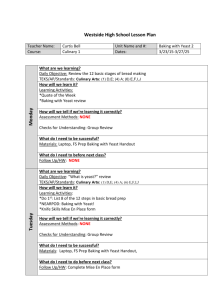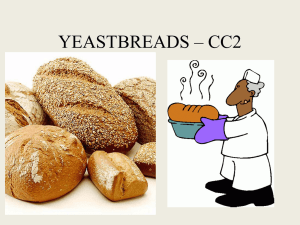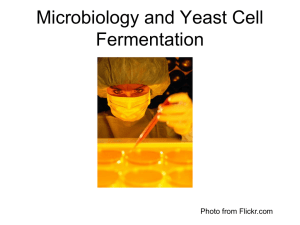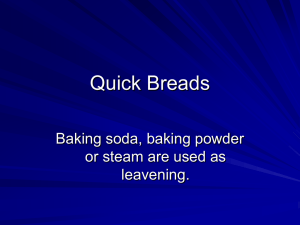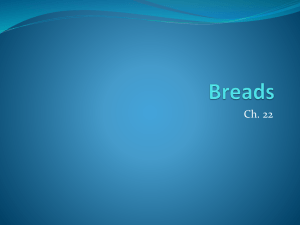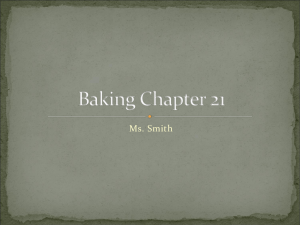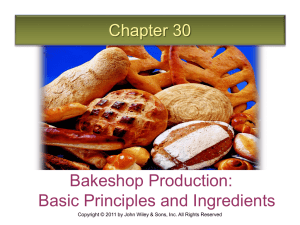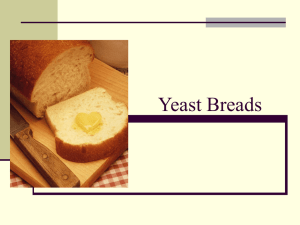Breads
advertisement
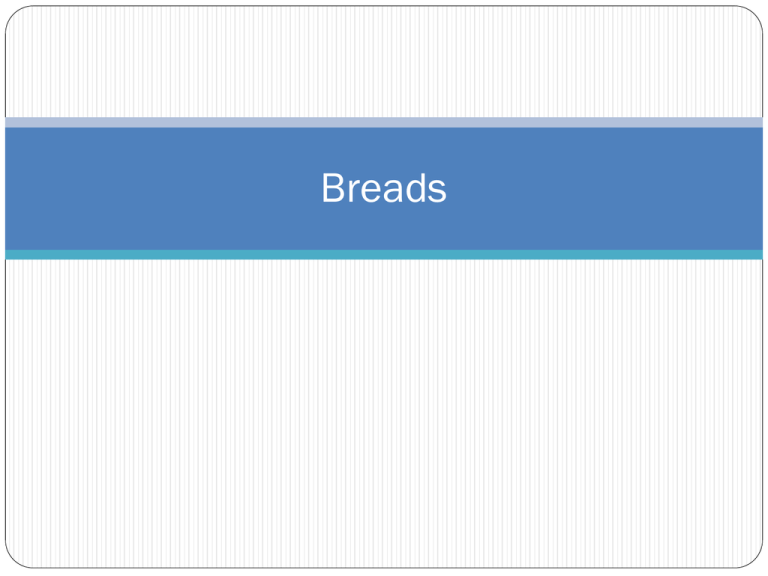
Breads Quick Breads Breads prepared in a short amount of time. -biscuits, muffins, popovers, cream puffs, griddle cakes, coffee cakes, and waffles Selecting & Purchasing Bread Freshly baked items: sold in bakeries or in supermarkets. Brown-and-serve: partially baked, need a final browning before eating/serving. Refrigerated doughs: ready to bake Frozen doughs: must be thawed out before baking. Selecting & Purchasing Bread Cost of Baked Products Storing Baked Products Ready to serve items are Store bread at room temp. more expensive simply because they are convenient. or in the freezer. Keep refrigerated and frozen doughs in refrigerator/freezer until you’re ready to use them. Dinner rolls from a bakery cost more than frozen dinner rolls. Ingredients Flour Bread flour: contains largest amounts of gliadin and glutenin, the strongest and most elastic gluten. Use for yeast breads All-Purpose flour: contains gluten that is not as strong as in bread flour. Use for yeast and quick breads Cake flour: contains the weakest form of gluten. Use for baked products with a delicate texture Flour Gives structure Two proteins in wheat flour: gliadin and glutenin When combined with liquid, these two proteins create gluten. Gluten: gives strength and elasticity to batters and doughs. Leavening Agent Leavening agents produce gases in batter and dough that make baked products rise and become light and porous. The 3 leavening gases are air, steam (water vapor), and carbon dioxide. Air: beating eggs, creaming fat and sugar together, sifting flour, folding doughs, and beater batters incorporate air into baked products. Steam: High temperatures used in baking heat liquid ingredients enough to form steam. Popovers and cream puffs are leavened mostly by steam. Leavening Agents cont… Carbon dioxide: A result of chemical reactions that occur between ingredients in baked products. Three ingredients may be used to produce carbon dioxide: yeast, baking soda, baking powder. Baking soda: When added to a flour mixture and heated, baking soda releases carbon dioxide. Baking powders: Most baking powders are double-acting baking powders. Too much baking powder will produce too much carbon dioxide and the product will collapse. Too little and the product will be small and compact. Liquids Fat Water, milk, fruit juice are A tenderizing agent in common liquids in bread. Eggs and fat are also considered liquids. They hydrate the protein and starch in flour. They also moisten/dissolve ingredients such as baking powder, salt, and sugar. They also serve as leavening agents when they covert into steam during baking. baked products. Aids in leavening. Eggs • Eggs help incorporate air into baked products when you beat them. • They add color and flavor and contribute structure. Sugar Salt Gives sweetness to baked Adds flavor. products. Has a tenderizing effect and helps crust brown. Batters & Doughs Batters: range in consistency from thin liquids to stiff liquids. Thin liquids are called pour batters, they have a large amount of liquid and a small amount of flour. Used for griddle cakes and popovers Stiff batters are called drop batters, they have a large amount of flour. Doughs: have an even higher proportion of flour. All quick breads contain gluten. If you mix or handle a batter or dough too much, the gluten will overdevelop. This can cause a quick bread to be compact and tough. To keep quick breads light and tender, mix them for only a short time and handle them carefully. Mixing Methods Biscuit Method Used for making biscuits and pastry Sift the dry ingredients together into a mixing bowl. Use a pastry blender, two knives, or your fingers to cut the fat in to the dry mixture. Continue cutting in until the particles are the size of coarse cornmeal. Add the liquid last. Preparing Biscuits Rolled: Sift the dry ingredients into a bowl. Then cut in the fat. Add the liquid all at once and stir until the dough forms a ball. Turn the dough out onto a lightly flour surface and gently knead 8-10 times. Roll/pat dough into a circle and cut it with a biscuit cutter. Bake them on an ungreased baking sheet. You can drop the batter from a spoon to make dropped biscuits. Bake dropped biscuits on a greased baking sheet. Characteristics of Biscuits Rolled: should have an even shape with a smooth and level top and straight sides. The crust is an even brown. When you break it open, the interior is white to creamy white. The crumb is moist and fluffy and peels off in layers. An undermixed biscuit has a low volume and a rounded top with a slightly rough crust. The crumb is tender. An overmixed biscuit also has a low volume and a rounded top, but the top is smooth. The crumb is tough and compact. Mixing Methods Muffin Method: Use to prepare muffins, waffles, griddle cakes, popovers, and some coffee cakes. Sift the dry ingredients together into a mixing bowl. Combine beaten eggs with milk and melted fat (all at room temp.) Add the liquid mixture to the dry mixture all at once, and stir the batter. The amount of stirring depends on the product. When making muffins, mix just until ingredients are combined. Preparing Muffins Use muffin mixing method. Characteristics of Muffins Should have a thin, evenly browned crust. The top should be symmetrical, but look rough. When broken apart, the texture is uniform, and the crumb in tender and light. An undermixed muffin has a low volume and a flat top. The crumb is coarse. An overmixed muffin has a peaked top and a pale, slick crust. When broken part, tunnels are visible. Preparing Popovers After mixing the ingredients, place popovers in a hot oven for the first part of the baking period. This allows steam to expand the walls of the popovers. Then lower the temperature to prevent overbrowning before the interior has set. Do not open the oven door to check popovers during baking, or they will not set and will collapse. Characteristics of Popovers A high quality popover has a good volume. The shell is golden brown and crisp, and the interior contains slightly moist (but not raw) strands of dough. If you have not baked a popover long enough it will collapse when you take it from the oven. The exterior will be soft instead of crisp, and the interior will be doughy. Preparing Cream Puffs A cream puff is a golden brown, hollow shell with crisp walls. Elongated cream puffs filled with custard are called eclairs. The dough for cream puffs is called puff paste. Begin baking in a hot oven so the steam will cause them to rise/puff. Then reduce the temperature to prevent overbrowning. Do not open oven door during baking, or cream puff will not set and collapse. Characteristics of Cream Puffs A properly prepared cream puff has a good volume and a brown, tender crust. When broken apart, the interior of the cream puff is hollow. A few strands of moist, tender dough may be visible. Under-baked cream puffs will collapse when removed from the oven. Cream puffs may ooze fat during baking. The evaporation of too much liquid can cause this. Microwaving Quick Breads Nut breads, muffins, coffee cakes, corn bread, and biscuits all microwave well. Popovers and cream puffs do not microwave well due to the lack of dry heat needed for crust formation (microwaves provide more of a moist heat) Use ring-shaped pans or muffin rings for more even cooking. Yeast Breads Bread products leavened with gases formed from chemical reactions with yeast. Leavening Agent :Yeast Yeast: Microscopic single-celled plant. Yeast: Compressed: made from fresh, moist yeast cells Active dry: made from active yeast strain that has been dried Fast rising: made from highly active yeast strains Ingredients in Yeast Breads Milk: Adds nutrients and helps bread stay fresh longer. It also give bread a softer crust than bread made with water. Salt: regulates the action of the yeast Sugar: provides food for the yeast, influence browning, flavor, and texture Too much: the yeast works slowly Straight-Dough Method Soften yeast in warm water. Mix and knead the dough and place it in a covered bowl in the refrigerator. It will then double in size Bake the dough the next day. Sometimes called cool-proofed or cool-rise. Fast Mixing Method Works well with active dry or fast rising yeast. This method allows ingredients to blend easily and eliminates the need to soften the yeast. Sponge Method Mix the liquid, sugar, yeast, and part of flour together. (this mixture is called a sponge) When the mixture (sponge) becomes bubbly and light, add the cooled melted fat, the salt, and the rest of the flour to form a dough. Batter Method- “no-mix” The mixture is thinner than a dough and therefore eliminates the need for kneading. The stirring develops the gluten. This is the quickest of the mixing methods. Kneading Kneading develops most of the gluten. To knead means to press the dough with the heels of the hands, fold it, and turn it. You must repeat this motion until the dough is smooth and elastic. Fermentation After kneading the dough, you must allow it to rest in a warm place. During this time, the yeast acts upon the sugar in the bread dough to form alcohol and carbon dioxide. This process is called fermentation. The alcohol evaporates during baking. The carbon dioxide causes the bread to rise. During this time, the dough should at least double in volume. To check for this, gently push two finger into the dough, if an indentation remains, the dough as risen enough. Punching the Dough After the dough has completed the first rising, you must punch it down to release some of the carbon dioxide. Firmly push a fist into the dough. At this point some doughs require a second rising time. Baking Oven spring: During the first few minutes of baking, the dough will rise dramatically. After this occurs, lower temperatures so the bread finishes baking. After baking, remove bread from the pan and place in on a cooling rack. Cool completely before you slice or store it. Characteristics of Yeast Bread A high-quality loaf has a large volume and a smooth, rounded top. The surface is golden brown. When sliced, the texture is fine and uniform. The crumb is tender and elastic, and it springs back when touched. Characteristics of Yeast Bread If a yeast bread has been under/over-worked, the finished product will have a low volume. This is because carbon dioxide has leaked out of the dough If you allow bread to rise for too long before baking, it may have large, overexpanded cells. The top of the loaf may be sunken with overhanging sides (like a mushroom). The texture is course and may be crumbly. If you have not allowed bread to rise long enough before baking, it may have large cracks on the sides of the loaf and a compact texture.
